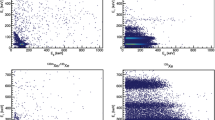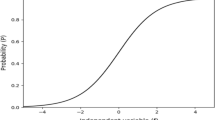Abstract
This special issue of the Journal of Signal Processing Systems focuses on advancement of signal processing and data-acquisition for radiation detection and measurements. The seven articles cover diverse topics within the scope of radiation detection ranging from understanding of fundamental fission process, instrumentation, and application of radiation interaction (e.g., tomography and imaging). The articles focus on signal processing for fission spectrometer, neutron and gamma-ray computed tomography and artificial intelligence methods, dynamic neutron imaging system, pulse-pileup correction in x-ray spectroscopy and calibration methods in radiation measurement.
Similar content being viewed by others
Explore related subjects
Discover the latest articles, news and stories from top researchers in related subjects.Avoid common mistakes on your manuscript.
This special issue of the Journal of Signal Processing Systems focuses on advancement of signal processing and data-acquisition for radiation detection and measurements. The seven articles cover diverse topics within the scope of radiation detection ranging from understanding of fundamental fission process, instrumentation, and application of radiation interaction (e.g., tomography and imaging). The articles focus on signal processing for fission spectrometer, neutron and gamma-ray computed tomography and artificial intelligence methods, dynamic neutron imaging system, pulse-pileup correction in x-ray spectroscopy and calibration methods in radiation measurement.
The article “Multi-channel detector module for multi-energy gamma ray computed tomography” by Bieberle et al. [1], presents an enhanced signal processing electronics with a simplified spectral measurement approach for gamma ray computed tomography using a multi-channel detector. It covers in-depth discussion of the proposed hardware electronics using a complex programmable logic device (CPLD) to provide parallel pulse height spectrum acquisition for each detector channel in a multi-channel detector. The signal processing electronics allow the selection of amplitude area, the number and the width of the pulse height channels. The performance of the developed CPLD based electronics was evaluated by measuring the pulse duration time spectra using a Cs-137 source and the results demonstrate that the spectroscopic performance matches with the commercially available multi-channel analyzer with intelligent data readout and low gamma photon detection dead time.
The article “Signal processing and data acquisition for the UNM fission spectrometer to measure binary fission product mass, energy, velocity, atomic number, and gamma rays, correlated particle- by-particle” by Baldez et al. [2], focuses on the development of the University of Mexico (UNM) fission spectrometer using dedicated detectors, analog electronics, and digital data acquisition to obtain correlated fission data sets. The individual fission events were identified using a coincidence between time of flight and detector signal. The UNM fission spectrometer consists of timing module detectors and a coaxial ionization chamber. The detector signal pulses were processed by analog signal processing to extract product time of flight and ionization chamber drift time. A multi-channel digitizer is used to digitize the timing signals and gamma ray detector signals, to record the pulse heights and time stamps which allows us to set coincidence time windows in post-experiment analysis. Successively, fundamental atomic signature of the particles (velocity, kinetic energy, mass) was extracted on particle-by-particle basis from the ejected fission products which can be correlated to extract mass and atomic number of each fission product.
The article “Pulse pile-up correction by particle swarm optimization with double-layer parameter identification model in X-ray spectroscopy” by Xiao-Feng et al. [3], describes a novel pulse pile-up identification method based on particle swarm optimization, double-layer parameter model and S-K inverse derivation. The proposed method takes the Gaussian pile-up pulses as an input and then analyzes the shape of the pulses to determine the amplitude, generation time, time constant and other parameters without a-priori knowledge of the modeling parameters to model the original detector pulses. Thus, it overcomes the model mismatch and associated errors. Computer simulations and experimental measurements were conducted to validate this model and the results demonstrate that using the proposed method pile-up pulses can be accurately identified.
The article “Sensitivity analysis of calibration methods and factors effecting the statistical nature of radiation measurement” by Kumari and Goswami [4], presents a method of recalibration using high voltage, amplifier gain, counting time and number of samples for scintillator detectors. Statistical analysis provides significant technical evidence that optimal electronics settings are mutually dependent upon sample size and measurement time. The optimized calibrated scintillator detectors were used for a computerized tomography experiment using a gamma radiation source for the verification of the proposed method. The optimal calibration settings results in improved image quality with higher accuracy and precision as compared to the non-optimal detector settings.
The article “Neutron tomography of spent fuel cask” by Liu et al. [5], proposes a framework and image reconstruction method for non-destructive investigation of dry casks for spent nuclear fuel to verify the content of the cask for safeguard purpose. A Monte-Carlo based framework was used to model the cask and generate projection data to evaluate the image reconstruction method. An iterative linear inverse approach combined with a convolutional neural network was used to reconstruct the cask and therefore identify missing fuel pin inside the cask. Additionally, the optimum operating parameters were also determined for the process to detect the missing pin inside the fuel cask. The proposed method is validated by modelling and simulating 14.1 MeV fast neutrons together with reconstruction algorithms to demonstrate the feasibility of neutron imaging of spent fuel.
The article “Characterization and implementation of a dynamic neutron imaging system at the PULSTAR reactor” by Datta and Hawari [6], demonstrates an application of a real-time neutron imaging system for non- destructive investigation of micro-bubbles in a two-phase flow environment. The present study validates a dynamic neutron imaging method at the PULSTAR nuclear reactor facility of the North Carolina State University. Initially, a simulation was done with COMSOL multi-physics software tool to perform a computational fluid dynamics analysis on formation of a bubble of a specified diameter within a water-filled box. Experimental investigations were performed with reactor’s thermal neutron source coupled with a scintillator detector and a CCD camera to measure the dimensions of the bubble experimentally. Experimental results show a close association with the simulation results. Multiple setups were used in the experimental study to find out optimized configuration for the image analysis system in terms of L/D ratio, binning methods, gain ratio, and exposure time.
The article “AI and conventional methods for UCT projection data estimation” by Kumar et al. [7], focuses on the development of automatic post-processing tools for signal and image processing for a Compact ultrasound computerized tomography (UCT) system. A comparison of conventional and artificial intelligence (AI) based imaging reconstruction methods between for ultrasound computed tomography applications has been presented. In addition to the post-processing techniques, the ultrasonic computed tomography (UCT) and associated data acquisition system were discussed. The transmission data was used to train the AI models and the reconstruction performance was compared with the traditional transform-based method. The proposed AI based method can handle and process a large amount of projection data generated in a UCT system with comparable performance to the conventional methods.
Collectively, these seven papers demonstrate a broad range of radiation detection and measurement applications reflecting current frontier of the research and signal processing methods from improvement of the instrumentation to inclusion and adaptation of machine learning.
References
Bieberle, A., Berger, R., Stave, P., & Hampel, U. (2021). Multi-channel detector module for multi-energy gamma ray computed tomography. Journal of Signal Processing Systems.
Baldez, P., Wetzel, M., Blakeleya, R., Ragsdale, A., & Hecht, A. A. (2021). Signal processing and data acquisition for the unm fission spectrometer to measure binary fission product mass, energy, velocity, atomic number, and gamma rays, correlated particle- by-particle. Journal of Signal Processing Systems.
Xiao-Feng, Y., Hong-Quan, H., Guo-Qiang, Z., Liang-Quan, G., Kai-ming, J., Ming, G., Chuan-Hao, H., & Mao-Lin, L. (2021). Pulse pile-up correction by particle swarm optimization with double-layer parameter identification model in x-ray spectroscopy. Journal of Signal Processing Systems.
Kumari, K., & Goswami, M. (2021). Sensitivity analysis of calibration methods and factors effecting the statistical nature of radiation measurement. Journal of Signal Processing Systems.
Liu, Z., Fang, M., George, J., Meng, L. -J., & Fulvio, A. D. (2021). Neutron tomography of spent fuel casks. Journal of Signal Processing Systems.
Datta, A., & Hawari, A. I. (2021). Characterization and implementation of a dynamic neutron imaging system at the pulstar reactor. Journal of Signal Processing Systems.
Kumar, A., Khare, P., & Goswami, M. (2021). Ai and conventional methods for uct projection data estimation. Journal of Signal Processing Systems.
Author information
Authors and Affiliations
Corresponding author
Rights and permissions
About this article
Cite this article
Saxena, S., Datta, A. & Chowdhury, R.P. Preface to the Special Issue on Signal Processing, Data Acquisition and Front-end Systems for Radiation Detection and Measurements. J Sign Process Syst 94, 345–347 (2022). https://doi.org/10.1007/s11265-021-01709-4
Received:
Revised:
Accepted:
Published:
Issue Date:
DOI: https://doi.org/10.1007/s11265-021-01709-4




